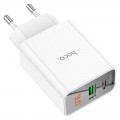USB-C ports
The number of
USB-C connectors provided in the design of the charger.
USB-C is a relatively new type of connector; it has dimensions slightly larger than microUSB and a double-sided design that allows you to insert the plug in either direction. At the same time, despite their compact size, rather advanced features can be implemented in such charging ports — in particular, high power supply and many fast charging technologies. On the other hand, specifically in chargers for gadgets, connectors of this type are much less common than full-sized USB (USB A), and in smaller quantities —
one at a time, less often
two. This is due to the fact that a cable is usually used to connect rechargeable gadgets, with detachable cables it is more convenient to use ordinary USB ports, and installing such ports in a charger (even a compact one) is easy. So in fact, it makes sense to specifically look for a device with USB-C mainly if the you have such a cable already (or a gadget with a suitable plug).
Features
—
Operation indicator. In some models it also provides additional information about operating modes, malfunctions, etc. Most often, such a light indicator is in the form of a separate light or a clearly visible backlight system. And additional information can be provided by changing the colour of the backlight, by blinking, etc. However, even without these features, the operation indicator provides additional convenience in use. In particular, it allows you to determine whether the charger is receiving power and working normally — this can be useful when diagnosing various problems. It is also possible to use non-standard backlighting — for example, as a night light that makes it easier to navigate in an unlit room (especially since gadgets are often put on charge just at night).
—
Display. Own display on the charger case. This is usually the simplest screen with a few characters, but it is enough to display various additional information that makes life easier for the user: current voltage and current values, fast charging status, error codes, etc. On the other hand, this complicates the design, but in fact such information is required less often; Therefore, very few chargers with displays are produced.
— Detachable charger power cable. Cable for connecting the charger to the power source, which has a removable design. By itself, connecting to a power outlet using a separate wire (both re
...movable and non-removable) is rarely used in charger devices — mainly in devices for which the “plug on the case” type design is not suitable (this is primarily wireless models, as well as wired charger devices with an abundance of connectors and corresponding dimensions). Specifically, the removable design is convenient in two ways: firstly, the wire can be removed and compactly folded for storage and transportation, and secondly, if the cable is damaged, it can simply be replaced, no need to bother with repairs. The disadvantages include an increased probability of losing the cable, as well as a slightly lower reliability than with a non-removable design (the latter, however, becomes noticeable only with frequent connections/disconnections that wear out the connector).
— Non-detachable charger power cable. Cable for connecting the charger to the power source, rigidly fixed to the device and not intended to be disconnected. It occurs much less frequently than the removable one described above, since it is less convenient if necessary to compactly fold the device; and if the wire is damaged, most likely, you will have to carry the charger to a service centre. On the other hand, you can lose such a wire only together with the charger itself.Cable included
The presence
of a cable in the delivery kit of the charger, or any other specific type of included cable.
The presence of a cable is indicated mainly for wireless devices (see “Type”) — in such cases, we are talking about the power cable of the charger itself. For wired models, the type of connectors on the stock wire (s) for charging gadgets is usually specified. At the same time, the USB port is used by default to connect to the charger itself, so this plug may not be mentioned in the description of the wire. On the other hand, there may be such connectors:
—
USB-C. A miniature version of the USB connector, gradually replacing microUSB in modern portable devices. It has a convenient reversible plug design, and can also provide some advanced power options not available with microUSB. Also note that USB-C can be used in a cable not only to connect to a gadget, but also to connect to the charger itself (along with traditional USB); so on the market you can find corresponding cables like "USB-C — microUSB", "USB-C — Lightning", etc.
—
microUSB. Universal connector, extremely popular in portable gadgets of various types; only relatively recently has it begun to give way to the more advanced USB-C (which differs from it in its one-sided design and lower power supply).
—
Lightning. Universal connector, used e
...xclusively in portable Apple devices. Like USB-C, it has a two-way layout, but a slightly different design.
